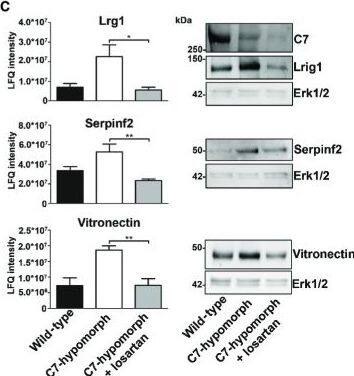Human Serpin F2/ alpha2-Antiplasmin Antibody
R&D Systems, part of Bio-Techne | Catalog # MAB1470

Key Product Details
Validated by
Species Reactivity
Validated:
Cited:
Applications
Validated:
Cited:
Label
Antibody Source
Product Specifications
Immunogen
Met28-Lys491
Accession # P08697
Specificity
Clonality
Host
Isotype
Scientific Data Images for Human Serpin F2/ alpha2-Antiplasmin Antibody
Detection of Mouse Serpin F2/alpha 2-Antiplasmin by Western Blot
Proteomics analysis reveals losartan-mediated reversion of early fibrotic changes in RDEBHeat map of cluster analysis of protein abundances determined by label-free quantification mass spectrometry. Extracted ion currents were used to determine protein abundances, and respective intensities were log2-transformed and normalized (z-score). Samples were clustered hierarchically, and protein abundances were clustered by k-means. Cluster sizes are indicated by color code on the left. Clusters 3, 4, 5, 8, and 9 highlight losartan-induced changes. The general patterns of protein abundance in clusters 5, 8, and 9 are similar in wild-type and losartan-treated C7-hypomorphic mice and thus contain downstream targets of losartan involved in RDEB disease progression. WT, wild-type; H, hypomorphic; H + Los, losartan-treated C7-hypomorphic skin.Proteins from cluster 5 carrying GO terms related to inflammation were short-listed and analyzed on potential interactions using default settings in STRING DB (confidence score 0.4) (Szklarczyk et al, 2015).Bar graphs show abundance of selected representative proteins in cluster 5 that were normalized by losartan treatment. Shown to the left are the mean ± S.E.M. of the normalized protein abundance (LFQ intensity) of groups of individual mice corresponding to wild-type, untreated, and losartan-treated C7-hypomorphic mice as indicated in the figure. Unpaired t-test was used to calculate significance. Abundance of Lrg1: *P-value C7-hypomorphic vs. losartan-treated C7-hypomorphic mice = 0.022; abundance of serpin f2: **P-value untreated C7-hypomorphic vs. losartan-treated C7-hypomorphic mice = 0.0084; abundance of vitronectin: **P-value untreated C7-hypomorphic vs. losartan-treated C7-hypomorphic mice = 0.0094. Right, validation of proteomics analysis by Western blotting of independent biological replicates. Representative Western blots of skin lysates from wild-type, untreated C7-hypomorphic, and 7-week losartan-treated C7-hypomorphic mice not used for proteomics. Blots were probed with antibodies against proteins as indicated. Erk1/2 and beta-tubulin served as loading controls. The analysis shows that there is a good correlation between proteomics data and abundance detected by Western blotting (n = 3 per group). Source data are available online for this figure. Image collected and cropped by CiteAb from the following publication (https://pubmed.ncbi.nlm.nih.gov/26194911), licensed under a CC-BY license. Not internally tested by R&D Systems.Applications for Human Serpin F2/ alpha2-Antiplasmin Antibody
Immunoprecipitation
Sample: Conditioned cell culture medium spiked with Recombinant Human Serpin F2/ alpha2-Antiplasmin (Catalog # 1470-PI), see our available Western blot detection antibodies
Western Blot
Sample: Recombinant Human Serpin F2/ alpha2-Antiplasmin (Catalog # 1470-PI)
Formulation, Preparation, and Storage
Purification
Reconstitution
Formulation
Shipping
Stability & Storage
- 12 months from date of receipt, -20 to -70 °C as supplied.
- 1 month, 2 to 8 °C under sterile conditions after reconstitution.
- 6 months, -20 to -70 °C under sterile conditions after reconstitution.
Background: Serpin F2/alpha 2-Antiplasmin
Serpin F2 is a member of the Serpin superfamily and the primary physiological inhibitor of the serine protease plasmin, which is responsible for the dissolution of fibrin clots (1, 2). In addition to plasmin, Serpin F2 is also an efficient inhibitor of trypsin and chymotrypsin (3). Liver and kidney are major sites of Serpin F2 production and other tissues such as muscle, intestine, central nervous system, and placenta also express its mRNA at a moderate level. The tissue expression pattern of Serpin F2 indicates that it is a key regulator of plasmin-mediated proteolysis in these tissues (4). Human Serpin F2 is synthesized as a 491 amino acid precursor with a 27 amino acid signal peptide. The secreted protein has a short propeptide (residues 28‑39) and a mature chain (residues 40‑491). The presence of the propeptide did not affect its ability to inhibit plasmin but reduced its cross-linking ability to fibrin (5).
References
- Tone, M. et al. (1987) J. Biochem. 102:1033.
- Silverman, G.A. et al. (2001) J. Biol. Chem. 276:33293.
- Potempa, J. et al. (1988) Science 241:699.
- Menoud, P.-A. et al. (1996) J. Clin. Invest. 97:2478.
- Sumi, Y. et al. (1989) J. Biochem. 106:703.
Alternate Names
Gene Symbol
UniProt
Additional Serpin F2/alpha 2-Antiplasmin Products
Product Specific Notices for Human Serpin F2/ alpha2-Antiplasmin Antibody
For research use only
